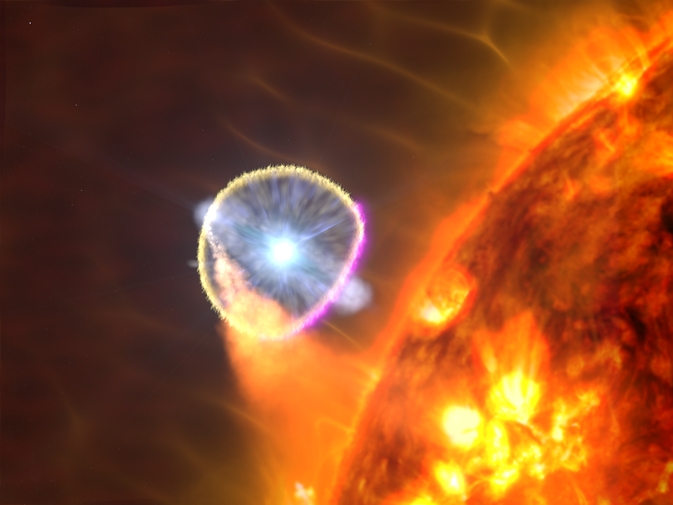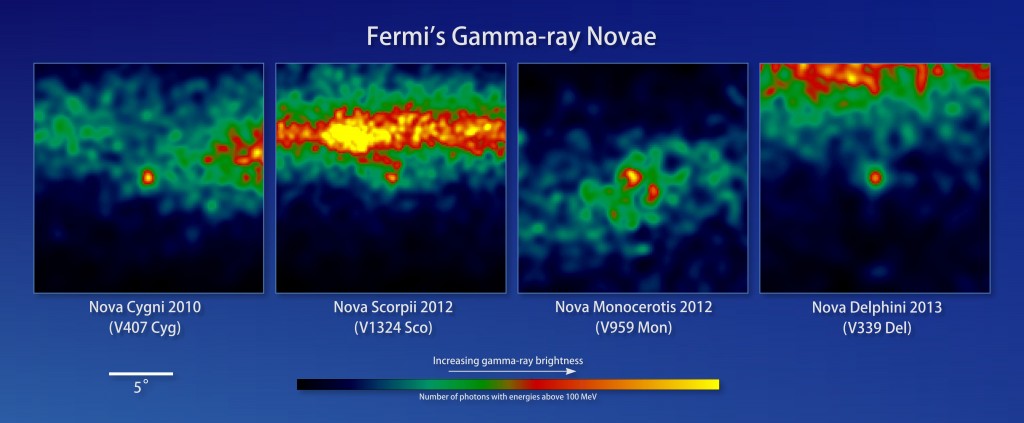Novae in Different Lights
- By Maggie Masetti
- November 25, 2014
- Comments Off on Novae in Different Lights
In part one of this series, we talked to researcher Laura Chomiuk about the scientific mysteries of novae V959 Mon. She has collaborated with two Blueshifters, Koji Mukai, and Tommy Nelson, who also study novae, but primarily at X-ray energies. We chatted with Tommy to learn more about his research in general and in specific regard to V959 Mon.
NASA Blueshift: Can you tell our readers a little about yourself?
Tommy Nelson: My name is Tommy Nelson, and I’m a research associate and lecturer at the University of Minnesota in Minneapolis. My background is in X-ray astronomy, primarily studies of novae in outburst and other accreting white dwarf binary systems. I was a postdoctoral researcher at Goddard for almost 3 years after graduate school, where I worked with Koji Mukai on science, and the wonderful Blueshift team on a few outreach projects. I left NASA primarily for family reasons – my spouse got a job here in Minnesota. However, I continued to work with Koji, Laura Chomiuk, and our colleague Jeno Sokoloski at Columbia University after I moved – mainly because they are all wonderful collaborators and I have so much fun working with them. Analyzing radio observations of novae was definitely a new, challenging experience for me, but it has given me a new, refreshing view of nova outbursts that I would not have obtained from X-ray studies alone.

The white dwarf star in V407 Cygni, shown here in an artist’s concept, went nova in 2010. Scientists think the outburst primarily emitted gamma rays (magenta) as the blast wave plowed through the gas-rich environment near the system’s red giant star.
Image Credit:
NASA’s Goddard Space Flight Center/S. Wiessinger
NASA Blueshift: Laura told us quite a bit about novae and her observations of them. How do x-ray observations add to the understanding of novae?
Tommy Nelson: X-ray observations of novae are wonderful because they can reveal the presence of any shocks in the ejected material. This is important if you want to understand why novae make gamma-rays, because our current theories of particle acceleration identify shocks as the location where particles are sped up to very high velocities. The detection of X-rays at energies above 1 keV indicates hot gas with temperatures greater than 1 million degrees – an undeniable signature of shocks. By measuring the temperature of the X-ray emitting gas, we can also figure out the difference in velocities between the fast and slow material, another important factor in determining how well shocks can accelerate particles.
X-ray observations are the ideal compliment to radio studies. While the VLA can reveal the shape of the ejecta and the amount of matter being thrown off during the outburst, X-rays add new information by telling us about the dynamics and energetics of the nova explosion.
NASA Blueshift: You also worked on the multiwavelength studies of the nova V959 Mon, which we interviewed Laura Chomiuk about. Your team’s first paper, led by Laura, focused on radio and gamma-ray observations. What other wavelengths did you use, and what additional information have those observations given you about this source?
Tommy Nelson: In addition to the radio observations that Laura’s paper focuses on, we also obtained X-ray observations of V959 Mon during the outburst with Swift, Chandra, and Suzaku. The X-rays have allowed us to constrain the difference in velocity between the two phases of mass ejection: something that wasn’t possible with the radio data alone. We also confirmed the internal shock picture by watching the X-rays become less absorbed by gas over a period of 3 months. This drop in absorption is due to the expansion of the slower ejected material ahead of the shock front. In other words, everything we see in the X-rays and radio ties together nicely! I’m currently writing these results up and we hope the paper will be out in the near future.
NASA Blueshift: What’s next for your research regarding novae?
Tommy Nelson: For now, my research will continue to focus on getting well-sampled, multiwavelength data sets for novae in outburst. We have really only started obtaining coordinated radio, optical and X-ray observations for novae in the last few years, and so the number of well studied systems is still small. We know that the behavior of novae varies widely from object to object, so in order to pin down some of the fundamental physical processes taking place—particularly those related to mass ejection—we need to increase our sample size.
NASA Blueshift: Thanks, Tommy!
We also chatted briefly with Koji to learn a little more about his involvement with the research. We love how it illustrates what a small community astronomy can be.
Koji Mukai: My involvement with this group initially started in February, 2006, with a phone call from Dr. Jennifer (Jeno) Sokoloski (who is now at Columbia University), because a star called RS Oph went nova, and Jeno wanted to organize an campaign of X-ray observations very quickly. We had met at conferences before, and Jeno knew I knew people who worked on RXTE and Swift at Goddard. I suggested using RXTE, and we ended up getting some really nice early X-ray data on RS Oph. Jeno and I have been collaborating ever since.
This 2006 explosion of RS Oph was observed by so many people using so many different instruments that a conference on this one nova was organized. There I met Tommy Nelson, who was working on a different set of X-ray data on RS Oph as a graduate student at Wisconsin. I ended up hiring Tommy as my post-doc to work here at Goddard. One day, Tommy was chatting with some friends (probably over coffee), who happened to mention that there is this new gamma-ray source which appears to be a nova. That’s how we first found out about gamma-rays from novae. Later, Tommy and I started working with Jeno and others on radio observation of novae, and it turns out Laura Chomiuk and Tommy are close friends from their Wisconsin days. Small world.




